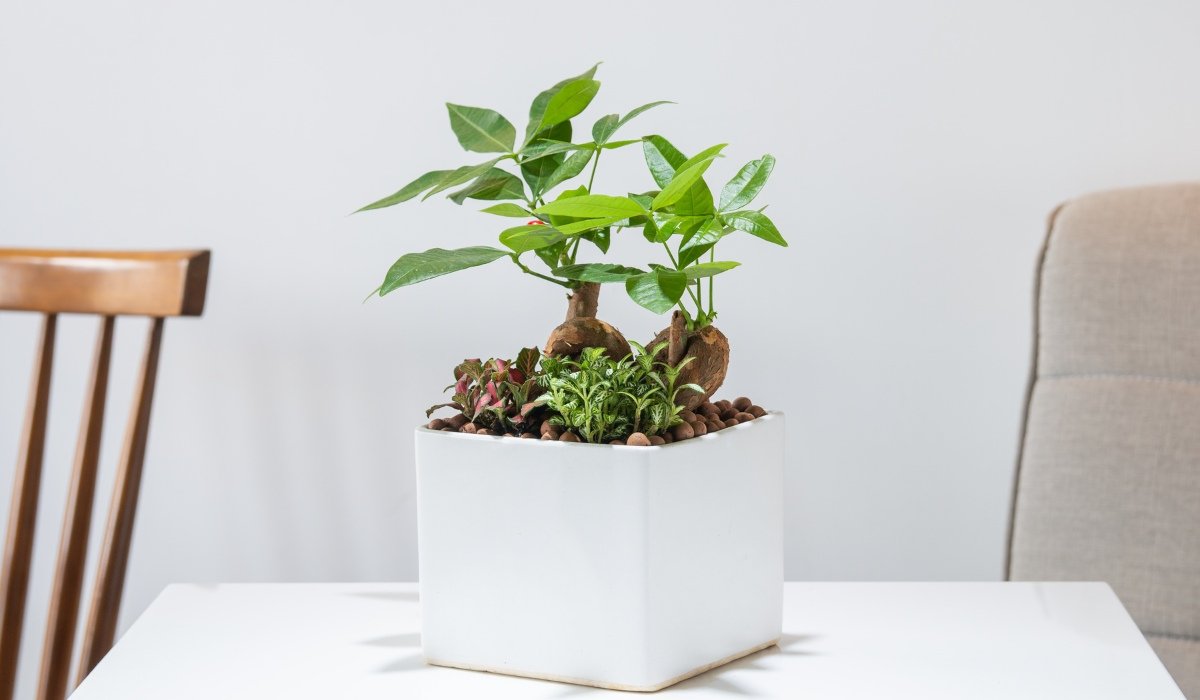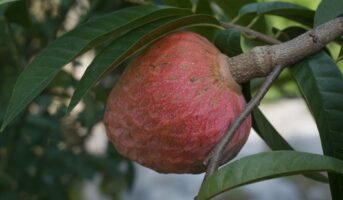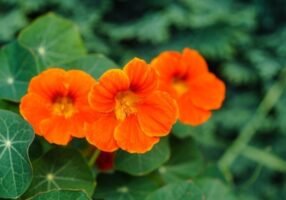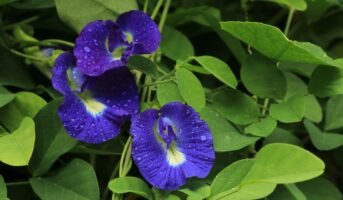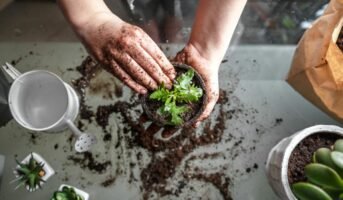Money plant or the Epipremnum aureum species is well-liked as a houseplant in temperate countries and has spread to forests in tropical and subtropical climates all over the world. Various common names for the plant include marble queen, taro vine, home plant, money plant, Solomon Islands ivy, silver vine, golden pothos, and Ceylon creeper.
Since it is virtually indestructible and stays green even when kept in the dark, it is also known as devil’s vine or devil’s ivy. In many regions of the Indian subcontinent, it is widely referred to as a money plant. It is believed to bring good luck, blessings and money to households.
Money plants, or Epipremnum aureum are renowned for being robust and simple to maintain. They can tolerate lower light levels but prefer to be in an area that is bright and well-lit. Long, cascading vines on money plants make for beautiful tables or hanging plants.
are renowned for being robust and simple to maintain. They can tolerate lower light levels but prefer to be in an area that is bright and well-lit. Long, cascading vines on money plants make for beautiful tables or hanging plants.
Money plants are excellent at eliminating harmful pollutants from the air. By eliminating common household contaminants from the air, they act as living air purifiers, transforming your room into a beautiful and healthy environment.
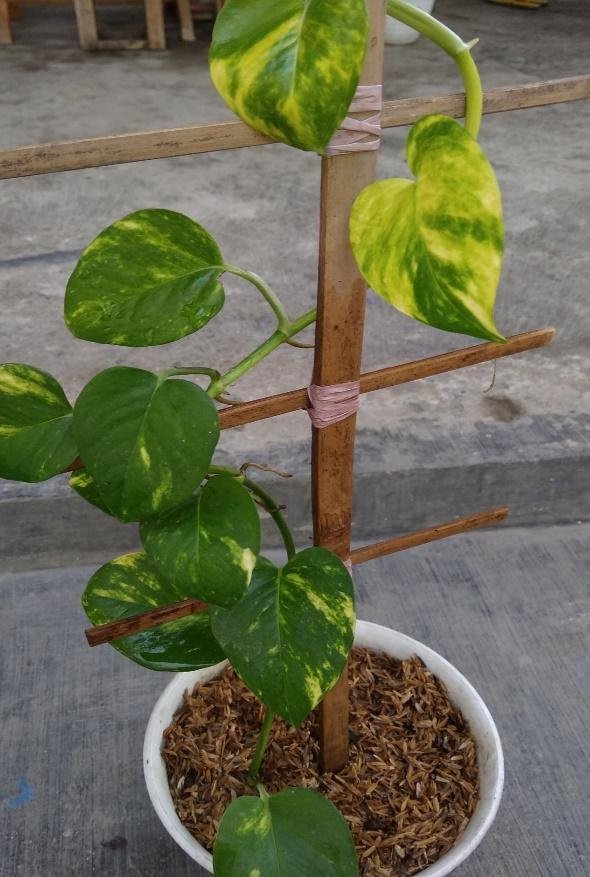
Source: Pinterest
Money plant: Key facts
| Scientific name | Epipremnum aureum |
| Tropical plant | |
| Common names | Money plant, marble queen, taro vine, Solomon Islands ivy, silver vine, golden pothos, Ceylon creeper |
| Temperature | 60-85°F |
| Flowers | White |
| Flowering season | Later winter/Early spring |
| Light | Low-light settings for indoors, gardens with direct sunlight |
| Location | Slightly sunny and partially shady location |
| Water | Enough watering |
| Humidity | High |
| Fertiliser | General purpose plant food spring-summer |
| Soil | Fertile and fast-draining soil |
| Common pests | Whiteflies, aphids |
| Maintenance | Low |
Types of money plant
This common house plant may thrive in a variety of climates. In India, you can find a variety of money plants. The varieties of money plants in the nation are covered in the section that follows.
Golden Money Plant
The golden money plant is also known as Devil’s ivy or Golden pothos. Beautiful golden or yellow splotches can be seen on the vivid foliage. They can be used on walls to define borders. Additionally, they look fantastic in the hanging pots on your balconies and gardens. These plants are very resilient and difficult to eradicate. Even without light, they may maintain their green colour and develop effectively.
Split Leaf Money Plant
This particular money plant species has broad leaves. It is a drought-resistant, quickly-growing houseplant that may thrive even in areas with little sunlight. Its leaves have a lobate shape and are rather large. When it begins to grow, you need to remain cautious since it can begin consuming the nutrients that are intended for other plants in your garden.
Marble Queen Money Plant
These money plants feature creamy-white coloured leaves. These plants are easily accessible in local nurseries. Bright sunlight is necessary for Marble Queens to maintain their stunning colours. Therefore, give your plants at least 4-6 hours of direct sunlight each day.
Marble King Money Plant
The striking white and green hues on the leaves set the marble king plant apart from the marble queen. The marble king is an excellent choice if you’re searching for a plant to keep indoors because the variegated patterns on its leaves look great in interiors.
Silver Money Plant
Silver money plant is often referred to as satin pothos and is well-recognised for its variegation and lovely foliage. These plants have stunning green leaves that are covered in shimmering silver patterns. It is better to grow them indoors because they thrive under indirect sunlight. Since they look their best when they are dangling from the pots, you can place these pothos plants close to windows.
Swiss Cheese Money Plant
The Swiss cheese money plant is another well-known indoor plant with large leaves. The plant’s gorgeously variegated, glossy leaves with a cheese-like perforation pattern are what give it its name. This climber can be grown both inside and outside of your home. The bright yet indirect sun is ideal for these plants to grow.
Big Leaf Money Plant
These plants have broad leaves and sturdy trunks. The best choice for you as a beginner is to grow a money plant with massive leaves. In addition to taking up more space and helping you cover soiled areas in your gardens, these plants are also relatively low maintenance and need little upkeep.
Jade Plant
Another common indoor plant that grows well in tropical climates. It is frequently an indoor plant, but you may also grow it outside. It requires little maintenance and may live in arid environments. This plant can be distinguished from others by its heart-shaped, dark green leaves. Place it on an elevated stool, and the plant’s falling foliage will give your rooms a classic feel.
Neon Money Plant
These money plants feature beautiful foliage that is noticeably different and distinctive. A neon or luminous look is provided by the vivid golden-yellow colour of Neon Money Plants. Young leaves exhibit this radiance more than adult ones do.
The golden money plant, sometimes referred to as golden pothos, is the most popular variety of money plant of all.
How to grow money plant in water?
Money plants are easy, enjoyable, and rewarding to grow in water. No specialised expertise or abilities are necessary to grow this plant. A few affordable supplies and some patience are all you need.
Many people love to grow money plants in simply a bottle of water, keep them close to a window, and watch them gracefully climb the glass. The care requirements for this plant would be different in such circumstances.
- Take money plants out of the ground.
- Take a cutting of a root with some newly sprouted leaves.
- Make sure there is no soil in the roots by thoroughly washing them in water.
- Pick a container.
- Add a few cups of coloured gravel stones to the container.
- Place the plant inside the container after it has been filled with water.
- For optimum growth, at least one node must be kept below the water’s surface.
- More nodes can be submerged in water by folding the branch into the water, which will encourage the growth of roots at all nodes.
- To encourage growth, the money plant container needs to be maintained close to sunlight.
- Water must be changed at least once a week.
- Water must be supplied often to keep the water level stable.
- There is no requirement to add fertilisers when the money plant is grown in water.
The maintenance of a money plant is really simple. Let the money plant stand tall with glossy leaves and provide more beauty to the area, whether indoors or outdoors.
How to grow money plant faster?
They are tropical climate plants that need humidity, well-drained soil, filtered sunlight, not too much direct sunlight, a lot of nutrients, and persistence. Although they don’t grow very quickly, they can flourish in a variety of environments. Although these plants are slow growing, they can grow much faster than their actual speed when the conditions are favourable. Try improving the conditions for the plant and monitoring it if you want it to grow quickly.
Here are some steps one should follow for the swift growth of this plant:
- Ideally, the water should be changed once a week.
- Avoid over-watering the plant because it could harm its growth.
- Regularly prune the plant. If not, it usually becomes challenging to maintain.
- The plant may become dry under direct sun. As a result, keeping it indoors would be preferable and more beneficial.
- To keep the plant healthy, remove any dried-out or dead leaves.
- As dry conditions typically impede its growth, misting the leaves might be beneficial for it.
- Synthetic fertilisers or pesticides should not be used.
Money plant: Care tips
Money plants require little maintenance. A properly maintained money plant can reach up to 12 feet of maximum height. This plant will grow up to around 7 feet tall if given average care. This is an excellent plant for those just getting started in gardening.
Money plant: Soil requirements
Money plants need soil that drains well. Therefore, one can combine regular potting soil with river sand. Sand provides plants with excellent drainage and aeration, allowing the plant to thrive. Additionally, potting soil with a high pearlite content is also an option (which is also used for cacti plants).
Money plant: Water requirements
The money plant is an odd plant since it can grow underwater or with enough watering. Overwatering can harm the plant’s growth, yet underwatering is still acceptable. Since the soil needs to dry out between waterings, watering a money plant once every seven to ten days is ideal during the summer.
However, the gap cannot be allowed to widen to the point that the ground begins to tremble. As a result, one can feel the topsoil’s dryness with their hands and decide whether to water again. Additionally, water blockage shouldn’t exist. In the winter, one should just spritz the foliage and only thoroughly water plants once every two to three weeks.
Money plant: Sunlight requirements
In general, money plants thrive in low-light settings, interior locations, and gardens with direct sunlight. For healthy growth of money plants, a place is also desired. Although this plant can withstand a considerable amount of sunlight, it’s important to keep in mind that searing rays will burn the leaves.
Therefore, choosing a slightly sunny and partially shady location in a lawn, patio, garden, or indoor area would be perfect for money plant care.
Money plant: Fertilising requirements
If you take good care of the soil, water, and sunlight offered to the money plant, you won’t need any fertilisers.
Money plants can be fertilised while being watered once a month. One must read the manufacturer’s instructions before applying fertiliser and only use the recommended amount. Another crucial point to keep in mind is that fertilisers should only be administered at night because doing so during the day could cause the roots to burn. Fertilisers should be avoided during the winter.
Money plant: Humidity requirements
Many money plants thrive in high-humidity conditions, requiring a moist environment to flourish. Misting the plant is an effective method to increase humidity and keep its leaves clean. Placing the plant in a room with a humidifier can also create the desired moisture level for optimal growth.
Money plant: Potting
The size of the plant always determines the pot size. Because the plant will eventually expand and need to be replanted in the future, it is preferable to choose heavy or large pots. Additionally, growth would be constrained in small pots.
Money plant: Pruning
During the early growing season, trim unwanted branches by making clean cuts just above a leaf node. Pruning encourages new growth as the plant focuses its energy on fresh shoots. Ensure your plant receives consistent indirect sunlight, as it provides the necessary energy for the emergence of new branches and leaves.
Money plant: Pests and diseases
Money plants can attract fungus gnats if their soil remains wet, while dry soil may lead to spider mites. Watch out for aphids and mealybugs too. Neem oil is an effective natural bug repellent for treating your plants. In potted plants, a sparing application of permethrin solution can help control fungus gnats.
Money plant: Benefits
Mentioned are benefits of the Money plant.
- It purifies air
- It reduces stress in the house
- It absorbs the radiation from the various devices in the house.
- It is a very positive plant that is believed to bring luck and money home.
Money plant: Significance in Vastu
In a money plant, every branch has 5 leaves which are green and shiny. These leaves grow for around 12 inches. The 5 leaves in each branch denote 5 elements of nature-namely fire, air, water, metal and wood. Since these elements together attract positive energy, money plant is believed to be a good luck and prosperity charm.
Money plant Vastu: Ideal direction
In general, plants usually provide a welcoming atmosphere in any home. They are in charge of making the air quality better, making the house look nicer, and even your mental well-being. However, did you know that money plants also offer other advantages in addition to these? It’s crucial to keep in mind that money plant Vastu plays a significant role while purchasing one.
According to Vastu shastra, your financial and emotional well-being is significantly impacted by the location and orientation of your money plant. Although this plant appears to be as ordinary as any other common houseplant, this is not the case. Unlike any other plant, it cannot be placed anywhere in the house.
One of the primary advantages of money plants for homeowners is the riches that they can attract, hence the name “money plant” is given. It assists in avoiding financial challenges and brings luck and wealth into your home. In terms of its placement, the money plant is significant, according to Vastu shastra. Here are all the important details to be aware of before putting a money plant in your home if you’re unsure about where to maintain one.
South-east direction
According to Vastu, Venus’s orientation in the southeast is ideal for money plants. The deity of the southeast direction is Lord Ganesha, who is renowned for removing barriers. This indicates overcoming challenges and ensuring your financial security. Lord Ganesha’s presence and Venus are both lucky omens that promise wealth and success.
Avoid placing the money plant in a water container and instead plant it in the soil in a brown-coloured pot if you are placing it in the southeast direction. Reds with deeper tones can also be used.
North-east direction
It can be problematic to keep your money plant indoors facing northeast in your house. Placing them in this direction has certain drawbacks and can cause financial problems and disagreements, and marital conflicts in your married life.
North direction
The northern entrance of your house is the ideal location for your money plant, so long as you have one. The north-facing money plant direction offers the residents of the house numerous work choices and newer sources of income. So, according to money plant Vastu, if you’re having trouble finding new work opportunities, you could place your money plant, also known as a golden pothos, at the north door.
See also: Areca Palm
Money plant: Vastu tips
Grow upwards
It is preferable to grow your money plant upwards. Since these Vastu plants are creepers, support is necessary for their growth. In this situation, people will cling to anything that offers them support. The heavier stems and leaves tend to sag and grow downward. Make sure your money plant at home grows vertically to avoid this. It is regarded as a sign of negativity to allow them to droop and grow downward. Allow these to ascend to the sky to gather all the good energy. The stems can be cut frequently to keep them from touching the ground.
Near electronic devices
We live in a world of computers, smartphones, and WiFi routers in the modern day. These gadgets release a large amount of radiation and are quite harmful to the body and mind of people. Money plants act as radiation absorbers for your home and shield you from the electromagnetic radiation that comes from your cherished gadgets. To reduce radiation, place your money plant indoors close to the WiFi router or television.
In the bedroom
Money plants can be kept in bedrooms, but if you want to keep one by your bed, avoid keeping it close to the headrest and footrest. Having the plant in your bedroom helps you sleep well, prevent disputes, and fight anxiety. It also reduces sleep disorders and improves the quality of your sleep.
All About: Vastu plants for home
Proper maintenance
Money plants offer several advantages, but they don’t ask for anything in return and only need average maintenance. They can reach a height of seven feet, even with very minimal attention. They can reach a height of 12 feet if given proper attention and care, enough light, and frequent watering. According to money plant Vastu, maintenance is vital to keep good fortune coming.
Avoid red
Red is a potent colour for conveying emotion, including rage, love, and usually danger. Avoid planting a money plant near any red objects or surfaces because doing so tends to bring bad luck. The general health of your household suffers as a result. The negative energy in the home will be harnessed by placing these Vastu plants for money near red backgrounds, especially kitchen appliances like washing machines, grinders, trash cans, etc.
Green and blue
Increasing the green and blue tones around your money plant is one technique to draw in more prosperity and positivity. Grow your money plants in vases or bottles that are blue or green. You can reuse old plastic bottles as planters or use vivid paint to decorate your pots. To increase the positive energy flow into your home, you can also add a painting of a beautiful scene as a backdrop.
In the corners
Sharp edges are a source of distress and negative energy, according to Vastu. Money plants can be positioned in corners to counteract the negative impacts, which will effectively reduce stress in the home.
Indoors
According to Vastu, keeping the money plant indoors offers the greatest advantages. It is thought that the money plant will draw more luck if it is in better health. One of the notable advantages of money plants is that they regulate indoor humidity, which raises the indoor temperature.
Do not give the plant to others
According to Vastu, giving a money plant to someone else will aggravate Venus, the goddess who bestows wealth.
Growing a money plant in an aquarium
It is a great technique to increase the flow of positive energies throughout the home. A money plant can be positioned on top of an aquarium. Let the aquarium water serve as the soil for the money plant’s roots to grow in. This arrangement helps to absorb nitrates in the water. It benefits aquatic life.
Airy corners
Although money plants need light, direct sunlight causes them to dry out. Be sure to choose open corners with some shade if you’re growing them outside.
Bathrooms
If you want to put it in your bathroom, make sure it’s close to a window facing southeast so it can expel any bad energy. Aside from the numerous advantages of money plants, they also give a splash of colour to any space.
Pruning
According to money plant Vastu, it’s unlucky to let someone trim the stems of your money plant. This might apply to any of your loved ones, friends, or neighbours. You are giving away your wealth if you let someone else chop off the leaf, stem, or tips. Additionally, this has a detrimental impact on the money plant.
Kitchen
Keep your money plants away from the kitchen. Keeping it close to these things can negate the good fortune and prosperity the money plant brings.
Money plant: Disadvantages
Selection of proper direction
Vastu Shastra states that if the money plant is not placed correctly in the house, it may experience a financial loss. Money plants should never be positioned towards the northeast. Because Deoguru, the representative of the northeast, is said to symbolise Jupiter and because Venus and Jupiter have a hostile relationship, this direction is thought to be the most unfavourable for this. So this Venus-related plant is in the northeast.
Effect on nerves
Another widely held myth is that money plants have an adverse effect on our veins. It is excellent if it is growing in the right upward direction; else, it is harmful.
You can’t gift it
According to Vastu, a money plant should never be given to someone else since it is believed to aggravate Venus and take the Lakshmi or Barkat of the recipient’s house with it.
Appropriate plants must be placed near money plant
Venus is supposed to be the planet of the money plant. Hence, Venus’s adversaries’ plants shouldn’t be planted, like the plants of Mars, the Moon, and the Sun.
FAQs
Is the money plant unlucky?
No! Money plants are not unlucky themselves, but they can attract bad luck if kept in the wrong direction.
Can money plants be kept in the bedroom?
Yes, you can, but avoid placing them anywhere near the headrest or the footrest.
| Got any questions or point of view on our article? We would love to hear from you.Write to our Editor-in-Chief Jhumur Ghosh at [email protected] |
Priya Banerjee, a writer with a keen eye on the property market, she deciphers the ever-changing trends in residential real estate. Priya excels at simplifying complex real estate terms, making them easy for everyone to understand. Her well-researched advice helps buyers and investors understand complex topics.
